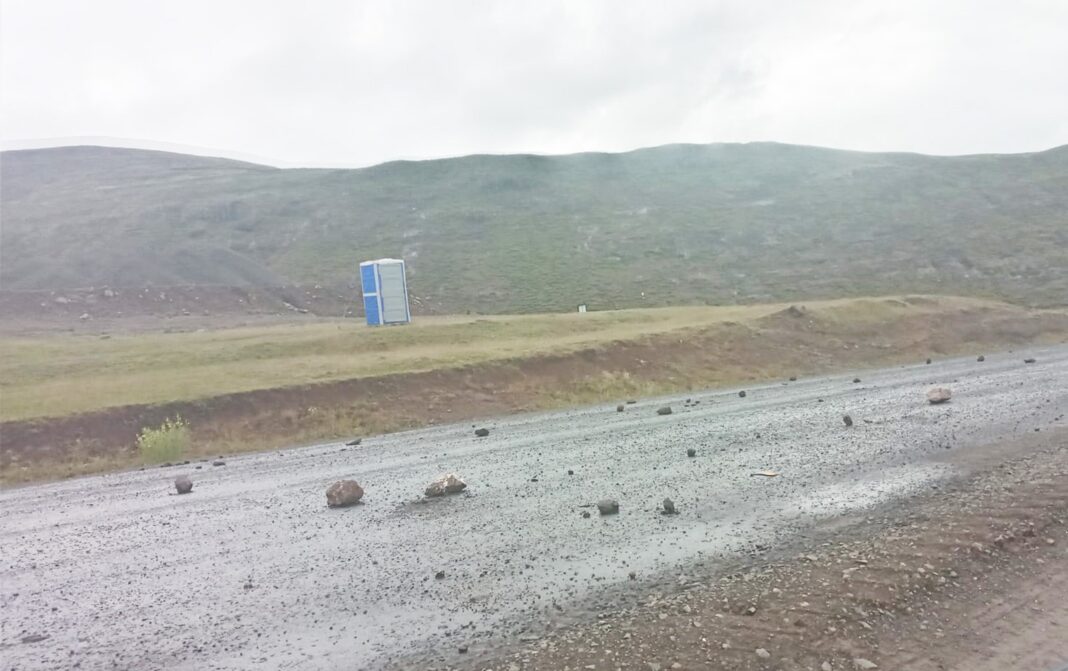By ‘Majirata Latela
The Lesotho Highlands Development Authority (LHDA) is blaming the delay to complete construction of the Polihali Northern Eastern Access Road (PNEAR) in Mokhotlong, on shoddy workmanship by a joint venture of Nthane Brothers (Pty) Ltd and Sinohydro.
The contract for the construction of the Polihali Northern-Eastern Access Road was awarded in October 2018 to Sinohydro and Nthane Brothers joint venture. The project was valued at approximately M232 million.
It entails the upgrading of the existing approximately 16km long gravel road to a Class A surfaced road from the town of Mapholaneng in north-eastern Lesotho to the Polihali dam site.
It is constructed to provide access to the dam site for construction vehicles and improve ease of movement for communities in the surrounding areas.
Speaking to this publication on the side-lines of a meeting with media managers in Maseru this week, the Lesotho Highlands Water Project’s Phase II divisional manager, Ntšoli Maiketso, said PNEAR was scheduled to be completed last year but the authority experienced challenges with the joint venture which at some stage reneged on the agreed construction standards and guidelines.
He said Nthane Brothers (Pty) Ltd complained that one of the layers of the road was impossible to attain and it therefore could not keep to the required standards. He alleged that when Nthane Brothers’ failed in its bid to circumvent the agreed guidelines, it unsuccessfully sought mediation from an arbitration committee as the committee ruled the company had a duty to keep its end of the bargain and complete the job to LHDA’s satisfaction.
“It took a long time for Nthane Brothers to give us a sample that we needed, of that layer of the road. To achieve the quality of the road that we wanted, we drew up specifications that we needed for the road and the different layers, but the contractor claimed it was impossible to do what we wanted.
“LHDA does not compromise on the quality of roads because those roads are not temporary. We need such infrastructure to be of good quality,” he emphasised.
He added not only were Nthane Brothers and Sinohydro disturbingly slow, but their performance is worrisome.
“We expect a great number of them to be finished next year around November. Some sections of the road as we have awarded to different contractors, we expect them to be finished this year,” he explained.
He added that some of the challenges encountered were a constant closure of roads by communities in the construction areas, causing an unforeseen delay in projects’ completion.
The communities felt their grievances relating to the project implementation were not being fairly addressed. Other grievances related to belated payments of compensation, being offered jobs and creation of some business opportunities.
Maiketso said the venture has consequently had to incur a penalty for failure to complete the works on time.
He said some construction delays were due to natural factors, which further prevented the works to be carried out on time. These factors include the heavy rains that poured for several weeks on end, resulting in suspension of operations.
“Also, the droughts that we suffered early last year delayed construction as the temperatures were too high for workers to be on site all day. As if that was not enough, ground conditions also posed challenges, with some of the places which had harder rocks forcing the contractor to spend more time on clearing the surface.
“The quality of roads constructed under Phase II will not only provide access to the Polihali Dam construction site but will also significantly influence sustainable economic growth through tourism and industrial development.
“AECOM SA (Pty) Ltd, working with AECOM Lesotho and Lesotho-based RWB Consulting Engineers, designed the Polihali West Access Road and the Rehabilitation of Northern Access Road and will supervise construction,” stated Tente Tente, acting chief executive of the LHDA.
The multi-phased LHWP is intended to provide water to the Gauteng region of South Africa and to generate hydro-electricity for Lesotho. The project entails harnessing the waters of the Senqu/Orange River in the Lesotho highlands through the construction of a series of dams, for the mutual benefit of the two countries.
The construction of the Polihali Dam which is the centrepiece of Phase II of the Lesotho Highlands Water Project was late last year said to be progressing very well as the underground tunnelling on the two Polihali diversion tunnels had been completed in August 2021.
According to LHDA, the breakthrough marked the completion of 1,870 metres of the tunnel excavation and was a significant step in Phase II construction
The LHWP is a project meant to build several dams in Lesotho to capture the waters of the upper Orange River basin and reverse part of its flow in order to provide South Africa, and in particular the Johannesburg region, with drinking water. Two tunnels are under construction to supply the Polihali Dam.
The dam will store part of the waters of the Orange River/Senqu and the Khubelu River. Its concrete rock fill wall will be 165m high with a ridge length of 921m and a ridge width of 9m. At its base, the slope will be 470m wide. The dam will have a spillway with a concrete side channel spillway.
Approached for comment, Nthane Brothers’ assistant general manager, ‘Mabakoena Nthaisane, said it is not true that the company is responsible for the delay in completion of the road, due to its failure or inability to put in place the layer in question.
“To the best of my knowledge, I am not aware of the delay you are talking about. What I do know, however, is the delays were due to Covid-19 restrictions and inclement weather.”









